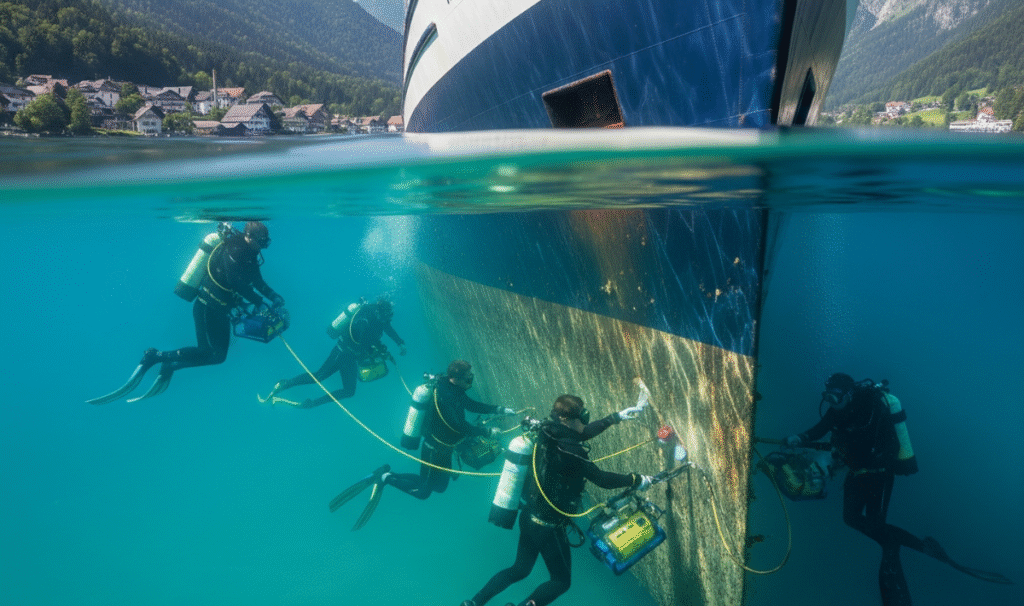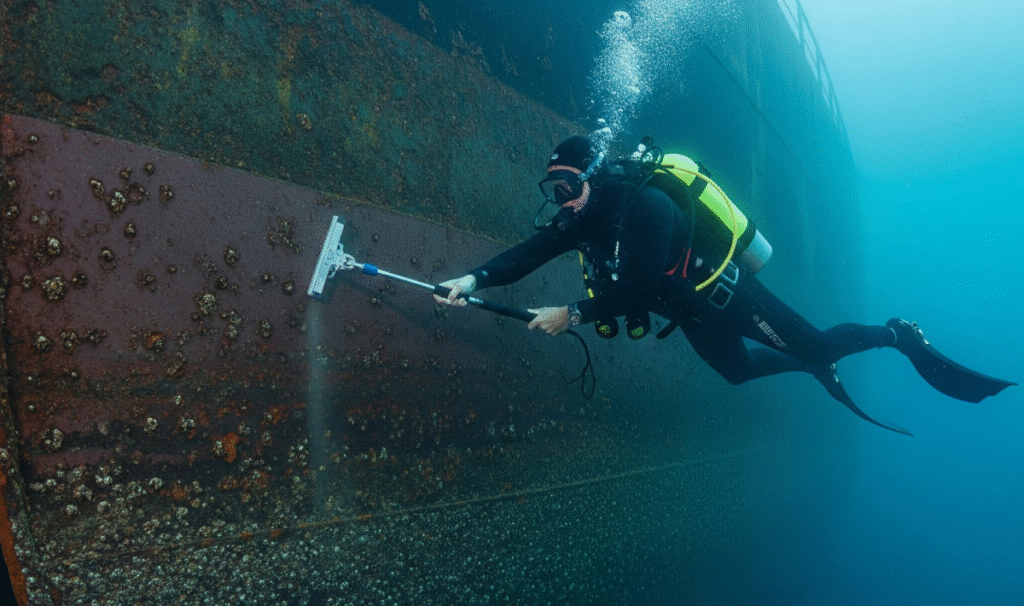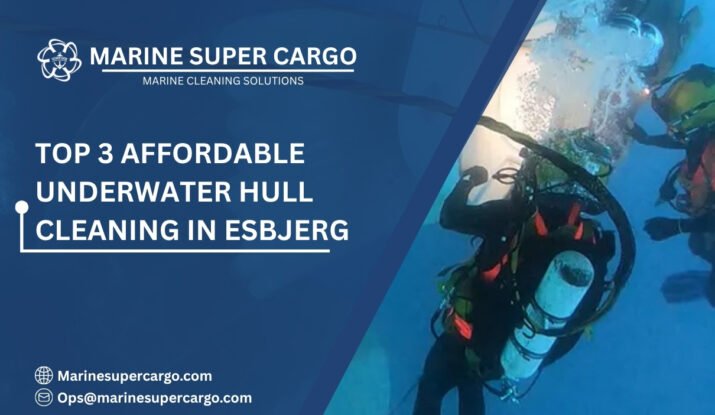Picture your vessel gliding through ocean waters—ideally sleek and efficient. But like sneakers caked in mud slow a runner, biofouling on your ship’s hull can turn every journey into an uphill slog. If your vessel operates anywhere near Denmark’s busy North Sea hub, underwater hull cleaning in Esbjerg is as necessary as oiling gears or checking navigation systems. Let’s explore why this maritime “spa treatment” matters to you, and how it’s transforming shipping for a cleaner, greener future.
What Exactly Is Underwater Hull Cleaning?
Simply put, underwater hull cleaning in Esbjerg is the professional removal of marine growth from the submerged surfaces of ships—whether at anchor, alongside, or even underway. This vital process restores your vessel’s smooth lines while helping maintain fuel efficiency and reducing emissions.
A clean hull means less drag, more speed, and lower fuel costs. However, it also ensures your vessel complies with international and local regulations, protects Danish waters, and supports the region’s transition to sustainable shipping.
Why Esbjerg Is the North Sea’s Cleaning Capital
Esbjerg is not just a port—it’s a regional powerhouse for cargo, energy, and fisheries. The port serves as an entryway to Danish, UK, and North Sea trade, and its hull cleaning facilities attract shipowners eager to operate efficiently, safely, and environmentally responsibly.
Here’s why underwater hull cleaning in Esbjerg is uniquely valuable:
- Denmark sets high environmental standards for its shipping industry.
- Esbjerg offers advanced cleaning tech, notably eco-friendly ROVs and diver teams.
- Local compliance and waste protocols are robust, so operations meet IMO and MARPOL norms.

The Technical Side: How the Cleaning Gets Done
Diver-Assisted Cleaning
Traditional methods rely on expert divers wielding hydraulic or pneumatic brushes. These pros inspect, clean, and polish areas prone to fouling—propellers, sea chests, thrusters, and the hull itself. Safety and coordination are paramount for successful cleaning in Esbjerg’s sometimes brisk waters.
This article draws on authoritative sites like IMO, Marine Insight (MARPOL), IMCA, IAPH, and cleanship.co to bring you up-to-date, trustworthy insights you’ll value as a ship owner or operator.
ROVs and Automated Systems
Innovative companies in Esbjerg are adopting Remotely Operated Vehicles (ROVs), such as the SeaBadger Mk2. These devices offer precision cleaning, full hull inspections via camera, and gentle brushless water jets that preserve antifouling coatings while removing even hard growth. Some ROV models can recover debris for proper disposal, minimizing impact on local ecosystems.
Fouling Monitoring and Data Capture
Leading providers use advanced sensors to map fouling build-up, producing tailored cleaning plans and performance benchmarks for your fleet. Video documentation provides proof of cleaning and assists with compliance audits.
Regulatory Compliance: MARPOL, IMO, and Local Rules
MARPOL Convention’s Role
The Marine Pollution (MARPOL) Convention, administered by the International Maritime Organization (IMO), sets global standards for hull cleaning and waste handling. Ships in Esbjerg must comply with MARPOL Annexes V and VI, which prohibit dumping waste and demand eco-safe procedures.
Local Port Regulations in Esbjerg
Port authorities in Esbjerg enforce strict guidelines for underwater cleaning—waste capture, debris collection, and environmentally friendly practices. Any non-compliance may result in fines or service restrictions. You’re expected to clean up and safely remove all waste after operations, ensuring the port remains pristine for all users.
Industry Standards
The International Chamber of Shipping (ICS) and IMCA recommend best practices for “in-water cleaning with capture” and regular record-keeping to demonstrate compliance. Divers and ROV operators in Esbjerg follow these standards closely, giving operators peace of mind.
Environmental Impact: Safeguarding the North Sea
Protecting Marine Ecosystems
Biofouling isn’t just a shipowner’s headache—it’s a vector for invasive species, harmful to Denmark’s fragile aquatic habitats. Ports like Esbjerg minimize this threat with systems that capture and safely dispose of all waste during underwater hull cleaning in Esbjerg.
Reducing Carbon Emissions
A fouled hull can increase fuel consumption by 20-40%, contributing to CO2 emissions. Routine cleaning means significant reductions in carbon footprint—a win for your budget and for global climate goals.
Eco-Friendly Cleaning Technology
Esbjerg’s providers emphasize non-toxic, water-jet cleaning, debris recovery, and avoidance of harmful chemicals. Cleaning agents or additives must not harm marine environments, per MARPOL and IMO guidance.
Cost-Saving Advantages: Why Cleaning Pays Off
Boosting Fuel Efficiency
The biggest payoff from underwater hull cleaning in Esbjerg? Less resistance means more kilometers per liter, so you save money every day your ship sails. For frequent callers in northern Europe, regular cleaning adds up to major annual savings on fuel and maintenance.
Extending Dry Dock Intervals
Proper in-water cleaning extends the time before you must dry dock your vessel, saving hundreds of thousands in lost time and expensive dock fees.
Reducing Wear and Tear
Cleaning your hull and niche areas (propellers, thrusters) regularly prevents vibration damage, ensures safer maneuvering, and prolongs equipment lifespan.
Innovations and the Future of Hull Cleaning in Esbjerg
Autonomous and AI-Driven Cleaning
Tomorrow’s hull cleaning combines ROVs, AI-driven fouling prediction, and remote data capture. Esbjerg is investing in research toward fully autonomous systems that work continuously, both at berth and underway, capturing real-time hull performance data.
Better Coatings and Surface Treatments
Next-generation silicone and foul-release coatings interact synergistically with cleaning systems, preventing severe growth and reducing cleaning frequency. Research in Esbjerg focuses on coatings that maximize fuel economy and simplify underwater cleaning operations.

Circular Waste Management
Some Esbjerg cleaning services recycle fouling waste for use in fertilizers or bioenergy, demonstrating circular economy principles and supporting Denmark’s reputation for sustainability.
Best Practices for Shipowners and Operators
- Schedule underwater hull cleaning in Esbjerg every 3-6 months, depending on routes and fouling risk.
- Keep a hull cleaning log, documenting inspections and cleaning events for compliance.
- Always verify that cleaning teams follow MARPOL, IMO, and local Esbjerg port protocols.
- Integrate cleaning cycles with hull condition monitoring to maximize ROI.
- Opt for cleaning partners that use ROVs, debris capture, and eco-friendly agents to minimize environmental impact.
Conclusion: Cleaner Hulls, Cleaner Future
Just as a sharpened blade cuts more cleanly, a ship with a well-maintained hull slices through the North Sea with ease. Underwater hull cleaning in Esbjerg is far more than a chore—it’s an investment in vessel performance, regulatory compliance, environmental stewardship, and operational cost savings.
With leading-edge technology, strict waste protocols, and a commitment to sustainability, Esbjerg positions your fleet for a cleaner, more profitable future. Give your ship its “spa day”—your bottom line and the planet will thank you.


